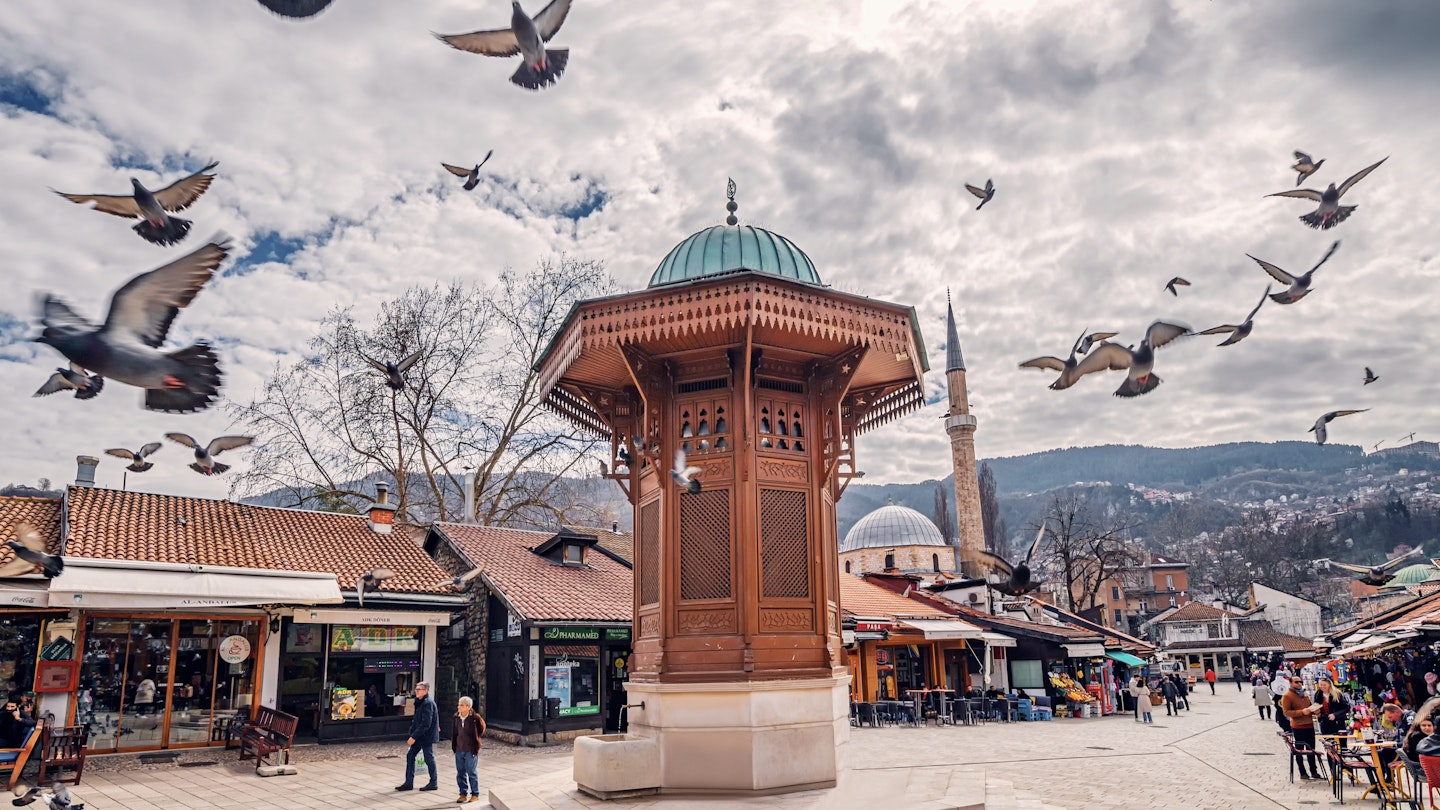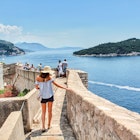

In Sarajevo’s Ottoman quarter of Baščaršija, you can savor smoky barbecue, sip local coffee and explore the historic buildings that stand side by side. Shutterstock
Sarajevo is renowned for its intriguing architectural medley, vibrant street life and the irrepressible spirit of its people.
Long renowned for its religious diversity, the capital of Bosnia & Hercegovina entered the world’s consciousness only in the 20th century – thanks to the 1914 assassination that precipitated WWI, the 1984 Winter Olympics and the brutal four-year siege that was a low point of the Yugoslav Wars of the 1990s.
- placement: fullWidth
- path: articles/in-content-top
- possible size: [970, 250], [970, 90], [728, 90], [300, 250], [320, 50], [1, 1],
- targeting:
{ "url": "guide-to-sarajevo", "destination": "Sarajevo", "continent": "Europe", "country": "Bosnia-&-Hercegovina", "city": "Sarajevo" }
Yet both despite and really because of this potent history, Sarajevo is place few visitors will forget. If you’re heading there for the first time, here’s what you should know.

When should I go to Sarajevo?
There’s no bad time to visit Sarajevo; even winter – when the shortest days regularly see below-zero temperatures – has its charm, especially if you enjoy snowy sports. Host of the 1984 Winter Olympics, Sarajevo boasts two Olympic-caliber skiing resorts: Jahorina and Bjelašnica, both about 25km (15.5 miles) from the city center. The skiing season runs from November to March, with February being generally the best time to visit for reliable piste conditions. Both resorts offer hotels near the slopes. If you’re not a fan of the cold, early November has more-manageable temperatures and is also when the three-day Jazz Fest Sarajevo takes place.
Spring and autumn offer ideal conditions for hiking in the mountains surrounding the city. Bjelašnica is a fantastic base for hiking to traditional mountain villages like Umoljani, a remote spot where customs have not changed for hundreds of years. You can also take Sarajevo’s cable car, which climbs some 500m (1640ft) up to a viewpoint 1164m (3820ft) on Mt Trebević, or go to the popular large park Vrelo Bosne. Locals love to go to this collection of lush mini-islands at the Bosna River springs for picnics or restaurant lunches on weekends
While summer draws tourists to the wider region, including to Mostar and the Croatian coast, Sarajevo stays cooler and is less thronged with tourists. Summer is also packed with cultural events, such as the Sarajevo Film Festival in mid-August. Every July, the wide-ranging arts festival Baščaršijske Noći sees music, theater and all kinds of performances take place in the city center.
- placement: fullWidth
- path: articles/in-content-middle
- possible size: [970, 250], [970, 90], [728, 90], [300, 250], [320, 50], [1, 1],
- targeting:
{ "url": "guide-to-sarajevo", "destination": "Sarajevo", "continent": "Europe", "country": "Bosnia-&-Hercegovina", "city": "Sarajevo" }

How much time should I spend in Sarajevo?
A weekend in Sarajevo will give you enough time to stroll the streets, eat out at restaurants and party with the locals. But we recommend adding a day or two on to your trip so you can venture out into the mountains and enjoy a hike or two with dramatic scenery.
Is it easy to get in and around Sarajevo?
Sarajevo is a very walkable city. And it’s easy to get between farther-flung destinations quickly thanks to an extensive network of trams and buses (including both so-called trolley buses and minibuses). You can pre-purchase tickets from kiosks, which are located on the main streets and easy to spot, or buy them directly from the driver as you board. Tickets must be validated once aboard; inspections to catch fare beaters are common.
Sarajevo International Airport is less than 10km (6 miles) southwest of Baščaršija. In town, you should have no problem finding a metered taxi to take you to the airport, yet at the terminal it’s not always easy to find a taxi prepared to turn on the meter.

Top things to do in Sarajevo
Absorb powerful testimony about the city’s recent past
For a powerful look at Sarajevo’s more recent history, visit the War Childhood Museum. This institution grew out of a 2013 book by Jasminko Halilović, who asked survivors of the Sarajevo siege, “What was a war childhood for you?” The museum features 50 of these personal stories, each accompanied by items donated by their authors – such as diaries, toys, and ballet slippers – that reflect their experiences growing up during the war. At the National Museum of Bosnia and Herzegovina, you can visit a permanent exhibit on “Surrounded Sarajevo,” which documents daily life during the 1992–95 siege.
Get into Sarajevo’s coffee culture
Sarajevo’s cafe scene is an essential part of local life. Don’t miss the legendary Caffe Tito, decorated with WW2 Partisan paraphernalia (there’s even a tank in the garden), and Zlatna Ribica, which is filled with antiques. When the weather is warm, tables spill onto the streets, and friends gather for hours, chatting and people-watching. Be sure to take your time: it’s completely normal to linger over a single drink for hours. If you’re out with locals, remember that the person who does the inviting usually picks up the bill.
Soak in the ambiance of Baščaršija
Spend a morning wandering around Baščaršija (pronounced bash-CHAR-shi-ya), the heart of old Sarajevo and centered on the Sebilj fountain. The quarter’s name is derived from the Turkish for “main market” – and it’s accordingly and lined with stalls, a lively coppersmith alley, grand Ottoman mosques, restaurants and lots of inviting little cafes.
- placement: native
- path: articles/in-content-native
- possible size: [f, l],
- targeting:
{ "url": "guide-to-sarajevo", "destination": "Sarajevo", "continent": "Europe", "country": "Bosnia-&-Hercegovina", "city": "Sarajevo" }
Take a walking tour through Sarajevo’s history
Follow Sarači St out onto the wide pedestrian boulevard Ferhadija to discover Austro-Hungarian Sarajevo. Some particularly grand examples of this period’s architecture line the riverfront, though the city’s pride and joy are the storybook neo-Moorish Vijećnica (City Hall) and the Old Orthodox Church, dedicated to the archangels Michael and Gabriel. The latter’s current form dates to 1730, but a church has stood on this site for much, much longer – possibly as far back as the 5th century.
Follow this up by a visit to the Jewish Museum, housed in a 1581 Sephardic synagogue that still sees active worship during Jewish New Year, to learn the story of Sarajevo’s Jewish community.

My favorite thing to do in Sarajevo
Living outside of my country of origin, I always miss Bosnian food. So when I return, I go for everything: stuffed peppers, tomatoes and onions. The best place to try these is Nanina Kuhinja in Baščaršija. My favorite barbecue staple – and the reason for all the smoke that wafts out of Baščaršija restaurants – is ćevapi (Bosnian kebab). Taste them at Željo, Sarajevo’s most famous ćevabdžinica (kebab shop). Naturally, I also regularly indulge in burek – filo pastry filled with meat, cheese, potato or spinach – and stuffed pita. Step into a buregdžinica (a bakery that specializes in pitas) and don’t forget to order a yogurt to dollop onto your bread.
How much money do I need for Sarajevo?
While prices have shot up in recent years, Sarajevo is still an affordable destination. You will be able to pay by card and Apple Pay in most places, although having some cash on you will come in handy for smaller purchases.
Hostel room: from 20KM (US$11)
Basic room for two: from 60KM (US$34)
Self-catering apartment (including Airbnb): from 70KM (US$40)
Public transport ticket: 2KM (US$1)
Coffee: 2KM (US$1)
Museum entry: 6KM (US$3–4)
Dinner for two: from 25KM (US$11–12)
Drink at a bar: from 4KM (US$2)
- placement: fullWidth
- path: articles/bottom
- possible size: [970, 250], [970, 90], [728, 90], [300, 250], [320, 50], [1, 1],
- targeting:
{ "url": "guide-to-sarajevo", "destination": "Sarajevo", "continent": "Europe", "country": "Bosnia-&-Hercegovina", "city": "Sarajevo" }
Explore related stories


 ToursThis survivor’s deeply personal tour of Sarajevo is the best way to understand Bosnia’s past
ToursThis survivor’s deeply personal tour of Sarajevo is the best way to understand Bosnia’s pastJun 9, 2023 • 5 min read

 Tips & AdviceA reason to travel to Croatia in 2023: meet the eurozone’s newest member
Tips & AdviceA reason to travel to Croatia in 2023: meet the eurozone’s newest memberJan 11, 2023 • 4 min read

 SportsTokyo 2020 is here - but what happens to Olympic venues after the Games?
SportsTokyo 2020 is here - but what happens to Olympic venues after the Games?Jul 22, 2021 • 3 min read


 HikingHere's what you can expect on a Lonely Planet Experiences tour of the Balkans
HikingHere's what you can expect on a Lonely Planet Experiences tour of the BalkansJan 20, 2020 • 5 min read

